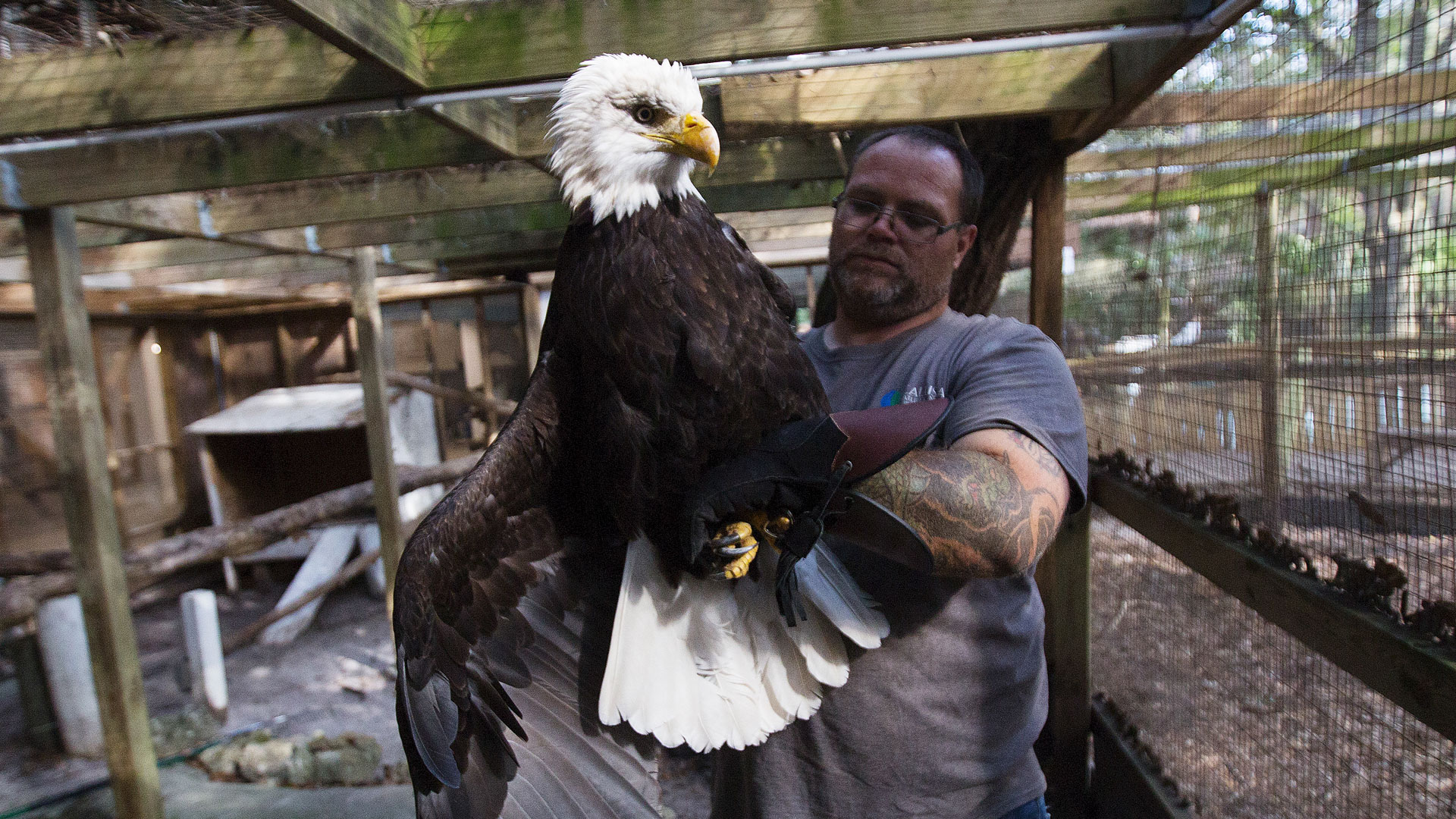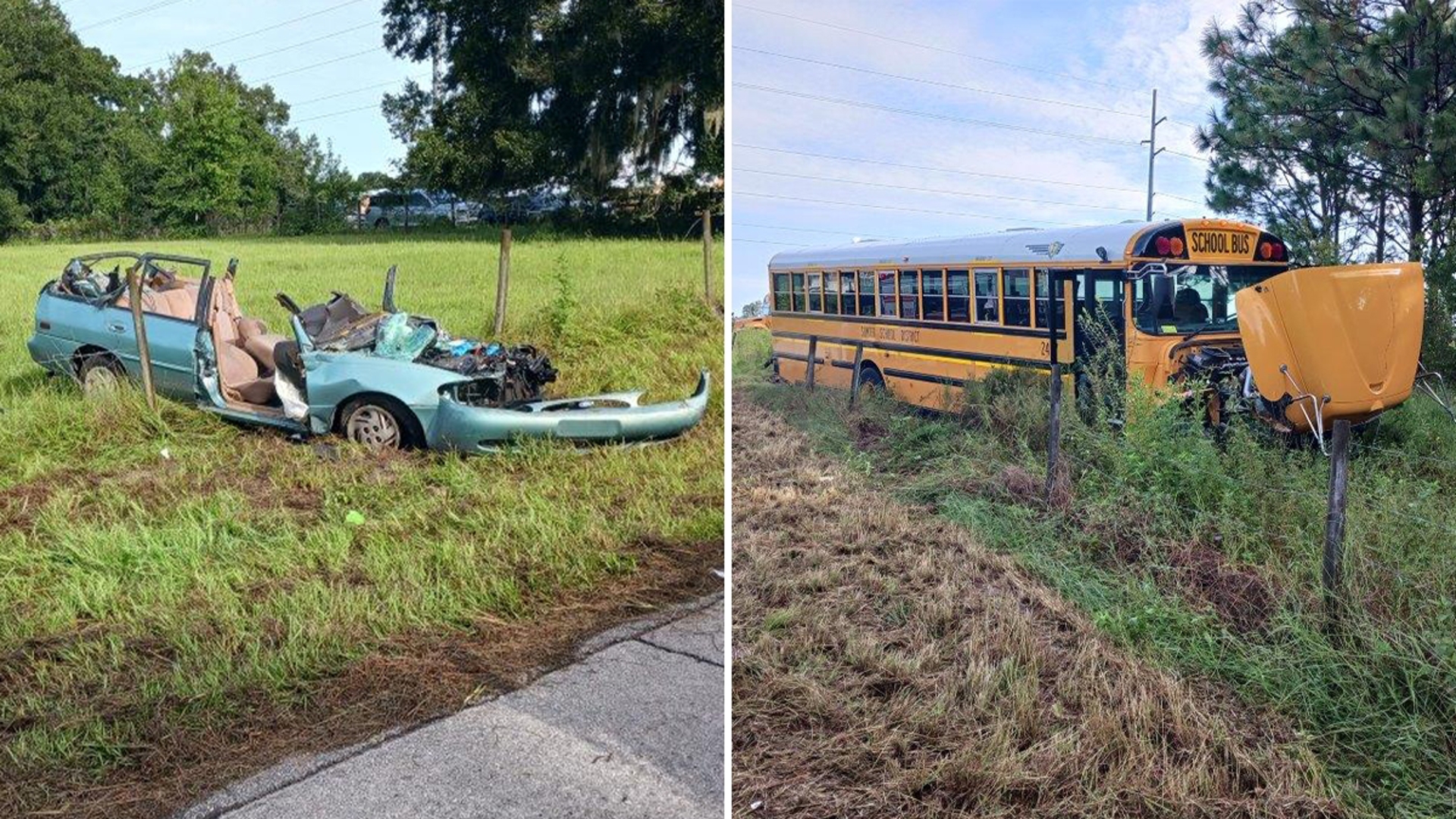At
Last October, the oft-repaired 30-year-old bird apartment failed a routine inspection. Florida Fish and Wildlife Conservation Commission Investigator Lar Gregory found it in "extremely poor condition. Many of the structural support beams are badly deteriorated and show signs of severe wood rot. ... no longer safe & suitable for use as an aviary," he wrote in his report.
The poor marks were hardly a surprise. Aviary repairs large and small are a constant of the center's routine. The leaky roof's been reworked, countless boards replaced and the screens fronting the enclosures patched so often there are zip ties holding zip ties.
But this time, Gregory gave the nonprofit an October deadline to replace the ratty structure.
A new one will cost $130,000, says board chairman and long-time environmental educator
The rarer, charismatic ones, like Erica the bald eagle, would likely find another sanctuary. But the loopy red-shouldered hawk? The teeny, half-blind screech owl? The car-crippled vultures? Not likely.
“They can’t fly, they can’t live in the wild. The reality is, they’re going to get euthanized,” says board member Jerry Higby. “Pretty much guaranteed.”
Which is why the nature center is mounting an all-out push to make sure that doesn’t happen.
“The old facility is essentially worn out,” says board member John Cassani. “It was built in the early 1980s, and now it’s three decades old. There’s probably a thousand tie wraps on the screening. It needs to be replaced. … We’re trying to create a happy, healthy and safe environment for these birds to live out the rest of their lives (and) we really need the public to help us, if for no other reason than these birds deserve it.”
It’s not just the money that's needed — volunteers and community awareness will be key to the mission’s success as well,Hammond says. That success, in turn, is critically important for the community surrounding the center, Hammond says, given how detached most people are from wild things and places. That’s why the aviary, the only one of its kind in the region, matters for more than the birds, he says
“We’re on our third generation of kids growing up without any real knowledge of nature,” Hammond says. “Where else can you get within three feet of a bald eagle and have it look you in the eye?”
That up-close intimacy thrills Cape Coral artist Barb Davis, who stood sketching a pair of broad-winged hawks on a recent afternoon. "It's like you can see into their souls," she marveled. And what does she see there? "Sadness," she says. "But so much courage."
A new aviary would also let the center expand its mix of species, affording Davis more subjects.
“I’d like to get another caracara (to replace one that died),” Hammond says. “And an osprey because people confuse ospreys and eagles all the time.” Higby raises his eyebrows. “They’re miserable in captivity,” he says.
“I know they are, and that’s a problem,” Hammond says. “But if you’ve got an osprey that can’t fly…” Higby finishes Hammond’s sentence: “Is its existence a good one?”
“That’s the ethical question we have to wrestle with all the time,” Hammond says. On balance, if the creature’s quality of life is good, the answer favors life.
Though the law requires gravely injured raptors to be immediately put down, it permits some, like these, to be kept in captivity for educational purposes. That exception allows the center’s birds to lead their lives safely and well-fed, tended by the same species quite likely responsible for them landing there in the first place.
Does this exposure to sunscreened tourists and shrieking schoolkids add unrelenting insult to the birds' injuries? To the untrained eye, they seem OK. They don’t pace or yank out their feathers. But to untrained eyes, the aftermath of their injuries — the wing stumps, empty eye sockets and maimed feet — can also be disturbing.
Case in point: Olivia the red-shouldered hawk with stargazer syndrome, a neurological problem that causes her to reflexively crane her neck sideways, one glittering eye to sky until she loses her balance, flapping frantically before toppling into a feathered heap.
Yet alarming as Olivia’s spells might be, she's otherwise not in distress. “She eats fine and is also personable,” says animal handler Jeremy Hargett, who tends her and is convinced she’d rather be alive.
“If we did not take these animals,” he says, “they would be destroyed. We find that disturbing and do everything in our power to let these magnificent birds live their lives to their fullest, with the respect they deserve.”
Cast of characters
Meet some resident birds at the Calusa Nature Center and Planetarium
Red-shouldered hawk, Buteo lineatus
If she were still well and at-large, Olivia would likely be hunting frogs, mice and the occasional songbird. It’s the latter penchant that landed her at the Calusa Nature Center and Planetarium.
“She chased a sparrow and didn't turn quick enough,” says animal handler Jeremy Hargett. “She ran herself into a tree (and) she suffered permanent brain damage.” The result is what’s called stargazer syndrome, which, as the name suggests, causes her to twist her head upward so she can keep one topaz eye on the sky. Problem is, it affects her balance as well, so Olivia easily loses her footing, with much flailing and flapping before she crumples to the sand. Then she picks herself back up and goes on about her business.
In the wild, red-shouldereds like Olivia generally pair up for life, returning to the same nesting area year after year to build a platform nest where both she and her mate would tend their brood of some two to four chicks. At the nature center, though, she rooms with a broken-winged female named Princess.
Bald eagle, Haliaeetus leucocephalus
For the last 15 years, Erica (short for America) has lived among humans, after someone shattered her left wing with a shot meant for a wild hog.
Some formerly wild eagles don't adjust to people, but Erica has. Instead of the fish, rodents, birds and sometimes carrion she'd have to find for herself in the wild, at the nature center, she dines on fish, rats and chicken, which she loves, says Education Director Amy Sera.
She may have lost her wing, Sera says, but Erica's feisty spirit is perfectly intact Meeting visitors' gazes with hers, sometimes cocking her head ever so slightly at their baby talk, the big girl (averaging about 13 pounds, females are usually 25 percent bigger than males) has become one of the nature center's ambassadors, "because of the personal connection that she makes with every guest," Sera says.
As many hawk species do, bald eagles also form lasting pair bonds, but Erica lives alone. In the wild, she'd return to the same nest with her mate year after year.
Great horned owl, Bubo virginianus
They call him Gandalf, and like Tolkein's venerable wizard, he's an arresting presence, with his searching stare and silver-dappled feathers. A car hit him, smashing a wing and leaving him unable to return to the woods. Though great horned owls are largely nocturnal in the wild, Gandalf is often alert and watchful during the day. He's also calm enough to travel to classrooms or fundraising galas.
His is Florida's largest and fiercest owl species. Ornithologist Arthur C. Bent dubbed them "winged tigers," noting that their prey includes "almost any living creature that walks, crawls, flies or swims, except for the larger mammals."
Great horned owls are also known to take over other big birds' nests, evicting the hawks or herons that built them, then laying their own eggs there.
Red-tailed hawk, Buteo jamaicensis
No one knows what happened to Steve, the Calusa Nature Center's red-tailed hawk, but his left wing was so badly broken it had to be amputated.
In the wild, red tails' varied diet includes rats, rabbits and squirrels and small snakes, though they're also known to carry off chickens and the occasional cat. Florida's largest hawk, they stay here year-'round, nesting in sabal palms, slash pines and live oaks.Their keen eyesight allows them to spot the slightest movement at 100 feet, and they can swoop to pounce on prey at speeds of 120 mph.
Highly territorial, red-tailed hawks use their keening squeals to warn off other birds — in the daytime, at least. At night, their territory often overlaps that of great horned owls' but because the owls are nocturnal, the big raptors avoid conflict.
Broad-winged hawk, Buteo platypterus
Wild and unconfined, these stocky hawks create what the famed Cornell Laboratory of Ornithology calls "one of the greatest spectacles of migration ... a swirling flock of broad-winged hawks on their way to South America." Also called "kettles,” these traveling groups can hold "thousands of circling birds that evoke a vast cauldron being stirred with an invisible spoon."
Their call is a shrill, two-tone cry, one that the nature center's broad-wing, Hugo, sends up frequently.He landed there after suffering a broken wing and an attack by a feral cat that should have left him dead, says animal handler Jeremy Hargett, but somehow, "he pulled through and (will) live the rest of his life here."
Help build them a new home
Tax-deductible contributions to the Calusa Nature Center and Planetarium's aviary fund can be made online at calusanature.org/aviary-appeal/ or sent to the Calusa Nature Center & Planetarium, 3450 Ortiz Ave., Fort Myers, 33905. Call 275-3435.


